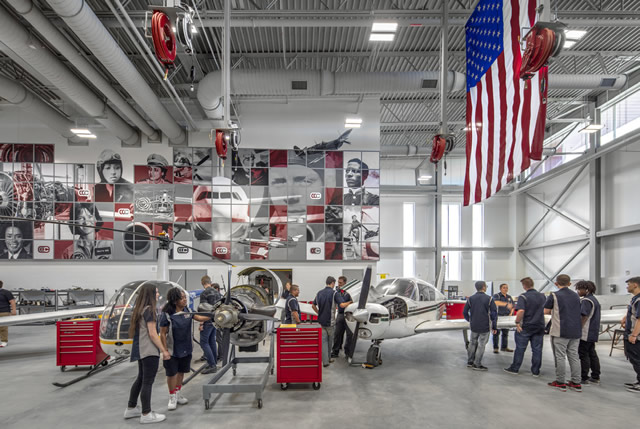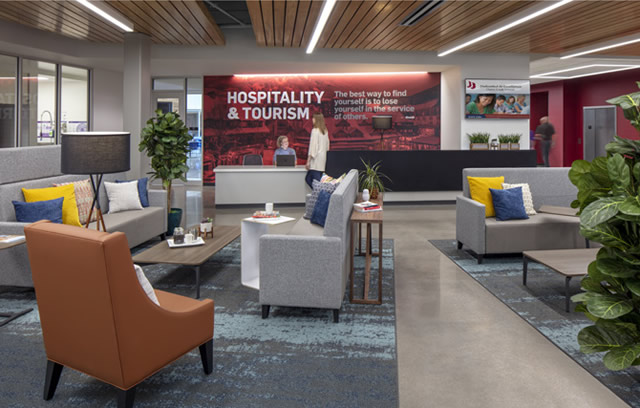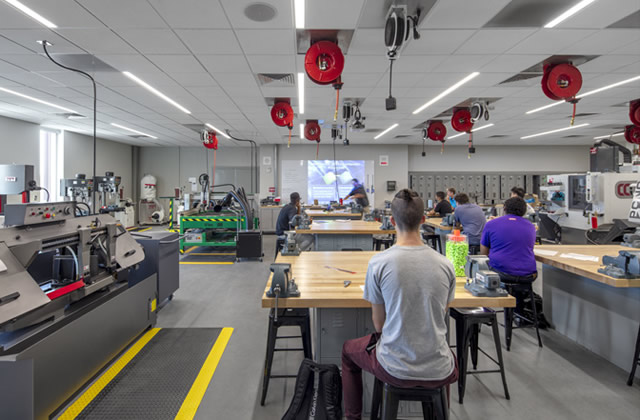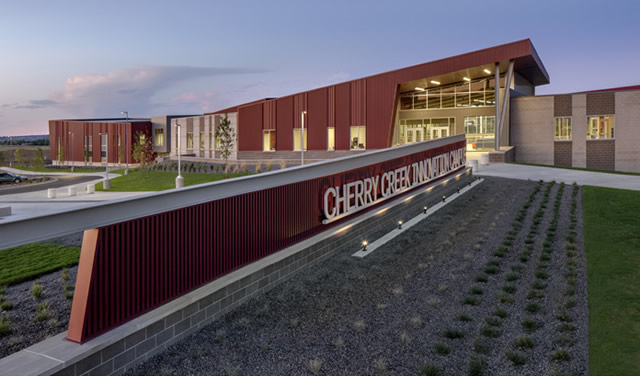A Changing Workforce Demands Change in Education
The new Cherry Creek Innovation Campus provides a hands-on experience and offers a curriculum rooted in real-world skills and trade certifications.
- By Pam Loeffelman
- 10/01/19
Innovation spurs creativity and
success. But what spurs innovation?
One hour south of Denver, in Centennial,
Colorado, innovation stems from a joint
effort between a district, a design firm, a
community and industry partners who are
committed to better preparing students for
the changing workforce.

In advance of a 2016 bond referendum,
the Cherry Creek School District embarked
on a community engagement process
intended to elevate environments and
opportunities for its learners. The capstone
of the initiative was a career and technical
education facility that focuses on innovation
and career and college readiness. Upon
the successful passage of the bond, DLR
Group was selected to lead the planning and
programming process that has resulted in a
unique synthesis of education and industry.
The process started when stakeholders
across the district gathered with DLR
Group’s design team to discuss how a
different approach to education could foster
real-world experiences, project-based
learning, relevancy, communication skills,
adaptability, teamwork and ultimately
bolster the pipeline for the next generation
of Colorado’s workers. The culmination of
this 32-month process is the new Cherry
Creek Innovation Campus.
“This is the first project I have worked
on that I truly believe will change education
for tomorrow because we created a
new building type that is neither education,
nor industry, but a combination of
both,” CCSD’s Assistant Superintendent of
Career and Innovation, Sarah Grobbel said.
Perched atop 40 prominent acres in
Dove Valley near the Denver Broncos
training facility, the 117,000 square-foot
campus features a variety of instructional,
lab and social spaces where students can
work in teams or individually on assigned
tasks as they progress through their chosen
career pathway. It is designed to accommodate
three types of learners: students who
plan to attend college take dual enrollment
courses to earn credit toward their college
degree; students who prefer to enter
the workforce or military immediately
learn skills or trades necessary for future
success; and students who have yet to
decide on a profession can further explore
interests and build skill sets that will give
them a competitive advantage as they enter
either college or the workforce.
“We challenged DLR Group to inspire
students the moment they entered the
building. Rather than thinking narrowly about participating in one pathway, we wanted students to see the
possibility of creating their own trajectory through multiple pathways
to meet their career exploration needs,” Grobbel said.

Career Pathways that Support Colorado’s Workforce
Home to advanced career-based courses, the campus expands
the career and technical programs currently available to students at
the district’s seven high schools. It also immerses students in an industry-based culture and climate. The district sought input from the
Colorado Workforce Development Council to pinpoint seven relevant
career pathways that support the local and regional economy:
- The Advanced Manufacturing pathway trains students on manufacturing
trends and working with computer numerical control equipment
including mills, lathes, water jets, routers and plasma cutters.
- Business Services students learn skills to cultivate an entrepreneurial
mindset in a collaborative, startup-style environment.
- The Health & Wellness pathway explores various allied health
professions at the aide/technician level, building competencies
through hands-on labs, authentic clinical settings and industry-grade equipment.
- Students in the Hospitality & Tourism pathway develop the culinary
abilities and skills to manage, market and operate food-service
establishments, hotels and resorts.
- Infrastructure Engineering students operate cranes and/or
forklifts, pour concrete and frame buildings to explore careers in
building trades.
- The IT & STEAM pathway prepares students to troubleshoot any
kind of personal computing device or computer network, as well
as to build their own virtual reality environments.
- Students participating in the Transportation pathway learn to
inspect, service, and repair automobiles and aircraft.

Designated areas for each pathway were designed with critical
input from business partners who established baseline needs and
space parameters to deliver authentic learning environments.
Many of these partners continue to be involved in the development
of courses that reflect the changing industry standards.
“From the first day of planning, we worked alongside industry
partners to develop curriculum and instruction for every pathway.
Because of this intentional collaboration, students are immersed in
experiences based on industry expectations and real-world applications,”
Grobbel explained. “Our industry partners are also excited to
spend time co-teaching at our building throughout the year.”
In collaboration with the district and DLR Group, industry partners
ensured every element (square footages, heights, loading on the floor,
access to specific spaces, FFE and equipment needs) was appropriately
defined. They also identified areas outside of the academic and lab
environments where socialization and demonstration could take place.
Career pathways converge at the heart of campus in the i-Commons,
a space that brings together all campus users by encouraging
interaction between students, educators and industry partners.
The i-Commons is an extension of the corridor space that links
programs and collaborative learning spaces together, allowing students
and professionals to linger, reflect, learn and cross-pollinate
to elevate the learner experience.

Cherry Creek Innovation Campus provides a one-of-a-kind
experience that supports the district’s community of learners,
encouraging them to explore, experiment and celebrate what their
future holds. With a curriculum rooted in real-world skills and
trade certifications, the campus is a new kind of bridge both to
college and to viable, successful careers.
This article originally appeared in the School Planning & Management October 2019 issue of Spaces4Learning.
About the Author
Pam Loeffelman, Principal, DLR Group. Pam leads DLR Group’s K-12 practice in the Southwest, elevating education for local school districts in Arizona, Colorado, Nevada and Wyoming. For more than 35 years Pam has been actively engaged in a dialogue about the return on investment of educational designs. She believes a combination of economic, social, and pedagogy trends, along with benchmarking can better shape the built environment so as to engage, and inspire students, educators, and local communities.